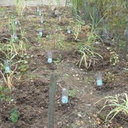Functional activity and functional gene diversity of a Cu-contaminated soil remediated by aided phytostabilization using compost, dolomitic limestone and a mixed tree stand.
Ключевые слова
абстрактный
Trace elements (TEs) availability, biochemical activity and functional gene diversity was studied in a Cu-contaminated soil, revegetated for six years with a mixed stand of willow, black poplar, and false indigo-bush, and amended or not with compost plus dolomitic limestone (OMDL). The OMDL amendment significantly reduced Cu and As availability and soil toxicity, and increased the biochemical activity and microbial functional diversity assessed with the GEOCHIP technique, as compared to the unamended soil (Unt). The OMDL soil showed significantly higher abundance of 25 functional genes involved in decomposition organic compounds, and 11, 3 and 11 functional genes involved in the N, P and S biogeochemical cycles. Functional gene abundance was positively correlated with nutrient contents but negatively correlated with Cu availability and soil toxicity. The abundance of microbial functional genes encoding for resistance to various TEs also increased, possibly due to the microbial proliferation and lower Cu exposure in the presence of high total soil Cu concentration. Genes encoding for antibiotic resistance due to the co-occurrence of TEs and antibiotic resistant genes on genetic mobile elements. Overall, phytomanagement confirmed its potential to restore the biological fertility and diversity of a severely Cu-contaminated soil, but the increase of TEs and antibiotic resistant gene abundances deserve attention in future studies.


